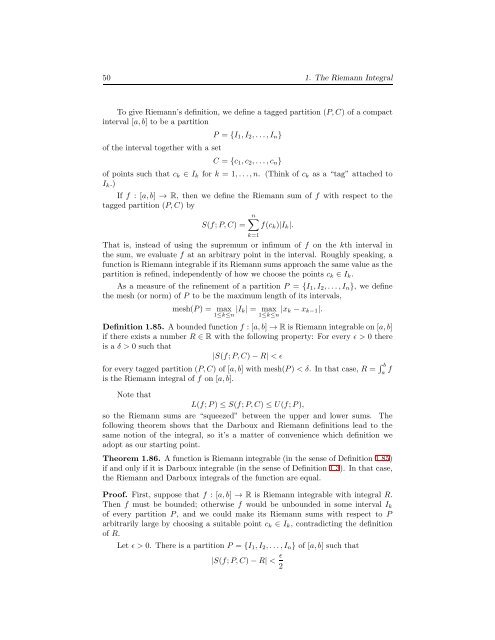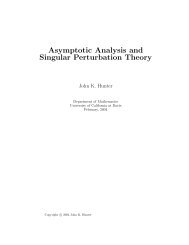The Riemann Integral
The Riemann Integral
The Riemann Integral
You also want an ePaper? Increase the reach of your titles
YUMPU automatically turns print PDFs into web optimized ePapers that Google loves.
50 1. <strong>The</strong> <strong>Riemann</strong> <strong>Integral</strong><br />
To give <strong>Riemann</strong>’s definition, we define a tagged partition (P,C) of a compact<br />
interval [a,b] to be a partition<br />
of the interval together with a set<br />
P = {I 1 ,I 2 ,...,I n }<br />
C = {c 1 ,c 2 ,...,c n }<br />
of points such that c k ∈ I k for k = 1,...,n. (Think of c k as a “tag” attached to<br />
I k .)<br />
If f : [a,b] → R, then we define the <strong>Riemann</strong> sum of f with respect to the<br />
tagged partition (P,C) by<br />
n∑<br />
S(f;P,C) = f(c k )|I k |.<br />
That is, instead of using the supremum or infimum of f on the kth interval in<br />
the sum, we evaluate f at an arbitrary point in the interval. Roughly speaking, a<br />
function is <strong>Riemann</strong> integrable if its <strong>Riemann</strong> sums approach the same value as the<br />
partition is refined, independently of how we choose the points c k ∈ I k .<br />
As a measure of the refinement of a partition P = {I 1 ,I 2 ,...,I n }, we define<br />
the mesh (or norm) of P to be the maximum length of its intervals,<br />
k=1<br />
mesh(P) = max<br />
1≤k≤n |I k| = max<br />
1≤k≤n |x k −x k−1 |.<br />
Definition 1.85. A bounded function f : [a,b] → R is <strong>Riemann</strong> integrable on [a,b]<br />
if there exists a number R ∈ R with the following property: For every ǫ > 0 there<br />
is a δ > 0 such that<br />
|S(f;P,C)−R| < ǫ<br />
for every tagged partition (P,C) of [a,b] with mesh(P) < δ. In that case, R = ∫ b<br />
a f<br />
is the <strong>Riemann</strong> integral of f on [a,b].<br />
Note that<br />
L(f;P) ≤ S(f;P,C) ≤ U(f;P),<br />
so the <strong>Riemann</strong> sums are “squeezed” between the upper and lower sums. <strong>The</strong><br />
following theorem shows that the Darboux and <strong>Riemann</strong> definitions lead to the<br />
same notion of the integral, so it’s a matter of convenience which definition we<br />
adopt as our starting point.<br />
<strong>The</strong>orem 1.86. A function is <strong>Riemann</strong> integrable (in the sense of Definition 1.85)<br />
if and only if it is Darboux integrable (in the sense of Definition 1.3). In that case,<br />
the <strong>Riemann</strong> and Darboux integrals of the function are equal.<br />
Proof. First, suppose that f : [a,b] → R is <strong>Riemann</strong> integrable with integral R.<br />
<strong>The</strong>n f must be bounded; otherwise f would be unbounded in some interval I k<br />
of every partition P, and we could make its <strong>Riemann</strong> sums with respect to P<br />
arbitrarily large by choosing a suitable point c k ∈ I k , contradicting the definition<br />
of R.<br />
Let ǫ > 0. <strong>The</strong>re is a partition P = {I 1 ,I 2 ,...,I n } of [a,b] such that<br />
|S(f;P,C)−R| < ǫ 2
















